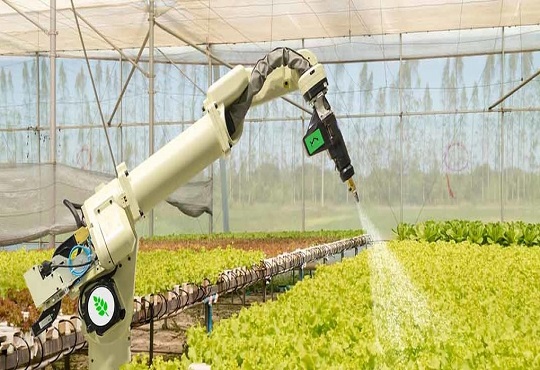Leveraging AI-based solutions to increase crop yield
Janifha Evangeline | Friday, 23 September 2022, 15:06 IST

Artificial Intelligence, Machine Learning & IoT sensors which render real-time data for algorithms help in improving crop yields, increase agricultural efficiencies & decrease the costs of food production. As per the UN’s prediction data about population & hunger, the global population will rise by two billion people by the year 2050. And, this would require a sixty percent surge in food productivity in order to feed them. Artificial Intelligence & Machine Learning are displaying their potential already to help close the gap in anticipated food requirements for an additional two billion people globally by 2050.
Let’s imagine that we have at least forty essential processes to keep track of, excel at as well as monitor at the same time over a large farming area that is often measured in 100’s of acres. Gaining insights into various factors such as how weather, migratory patterns of animals, birds, insects, seasonal sunlight, planting cycles & irrigation cycles, use of specialized fertilizers, insecticides by crop all affect yield is a perfect problem for ML. How financially successful a crop cycle has been always highly dependent based on excellent data. And, this is why farmers, co-operatives & agricultural development enterprises are increasing or even doubling down on data-centric approaches & expanding the scope as well as scale of how they use Artificial Intelligence & Machine Learning to improve agricultural yields & quality. Following are some of the ways in which AI has the potential to improve agriculture yield.
AI & ML-based surveillance systems for monitoring
Implementing Artificial Intelligence & Machine Learning-based surveillance systems for monitoring every crop field’s real-time video feed that identifies animal/human breaches, by sending an alert immediately. Artificial Intelligence & ML decreases domestic & wild animals’ potential to accidentally either destroy crops or experience a break-in or burglary at a remote farm location.
Given the swift advances in video analytics bolstered by Artificial Intelligence & Machine Learning algorithms, the stakeholders involved in agriculture can safeguard the perimeters of their fields & buildings. Artificial Intelligence & ML video surveillance systems scale as easily for a large-scale agricultural operation as for an individual farm.
ML-based surveillance systems can be programmed/trained over time in order to identify employees vs vehicles. Twenty20 Solutions - a leader in the field of Artificial Intelligence & ML-based surveillance & has proven effective in securing remote facilities, optimizing crops & deterring trespassers by leveraging ML for identifying employees working onsite.
Improves crop yield prediction
While Artificial Intelligence & ML enhance crop yield prediction via real-time sensor data as well as visual analytics data from drones, the amount of data recorded using smart sensors as well as drones rendering real-time video streaming offers agricultural experts with completely new data sets. This is something they have seldom had earlier. Furthermore, it is possible to combine in-ground sensor data of moisture, fertilizer as well as natural nutrient levels for analyzing growth formats for every crop over time. ML is the right & perfect technology for combining humongous data sets & offer constraint-based advice for optimizing crop yields.
Finding patterns in large-scale data sets
The agricultural technique which relies on supervised ML algorithms to finding formats in large-scale data sets & understand the orthogonality of these in real-time where all of which is invaluable for crop planning is Yield Cropping. Also, now it is possible to find out the potential yield rates of a particular field even prior to a vegetation cycle has ever begun. Implementing a combination of Machine Learning techniques for analyzing Three-Dimensional mapping, social condition data from sensors as well as drone-based data of soil color, agricultural specialists can predict the potential soil yields now for a given crop. A series of flights are compared for getting the most accurate data set possible.
Making AI & ML-based agribots & robotics a viable option for remote operations
There is a scarcity of several resources such as agricultural workers, which is making Artificial Intelligence and ML-based smart tractors, agri-bots & robotics a viable option for several remote agricultural operations that struggle for finding workers. Large-scale agricultural businesses cannot find sufficient workers hence they turn to robotics for 100s of acres of crops while also rendering an element of security through the perimeter of remote locations. Therefore, Programming self-propelled robotics machinery for distributing fertilizer on every row of crops facilitates in keeping operating costs lower & improve field yields, further.
Improving track & traceability of agricultural supply chains
What is a must-have today is improving the track-&-traceability of agricultural supply chains by eliminating roadblocks for finding fresher, safer crops to market. furthermore, the COVID-19 pandemic augmented track-&-traceability adoption over all agricultural supply chains in the year 2020 & will continue to fuel its adoption. A well-managed track-&-trace system enables reducing inventory shrinkage by rendering huge visibility & control across supply chains. A state-of-the-art track-and-trace system relies on advanced sensors for gaining knowledge of every shipment’s condition. RFID & Internet of Things (IoT) sensors are becoming a commonplace in the manufacturing industry now. The American multinational retail Walmart ran a pilot for seeing how RFID can streamline the track and trace performance of a distribution center & enhanced efficiency by sixteen times over manual methods.
In a nutshell
Artificial Intelligence is helping in solving the shortage of resources as well as labor to a greater extent & it will be a powerful tool which can help firms to cope with the surging amount of complexity in modern agriculture. Hence, it is high time that large firms invest in this space.


.jpg)

